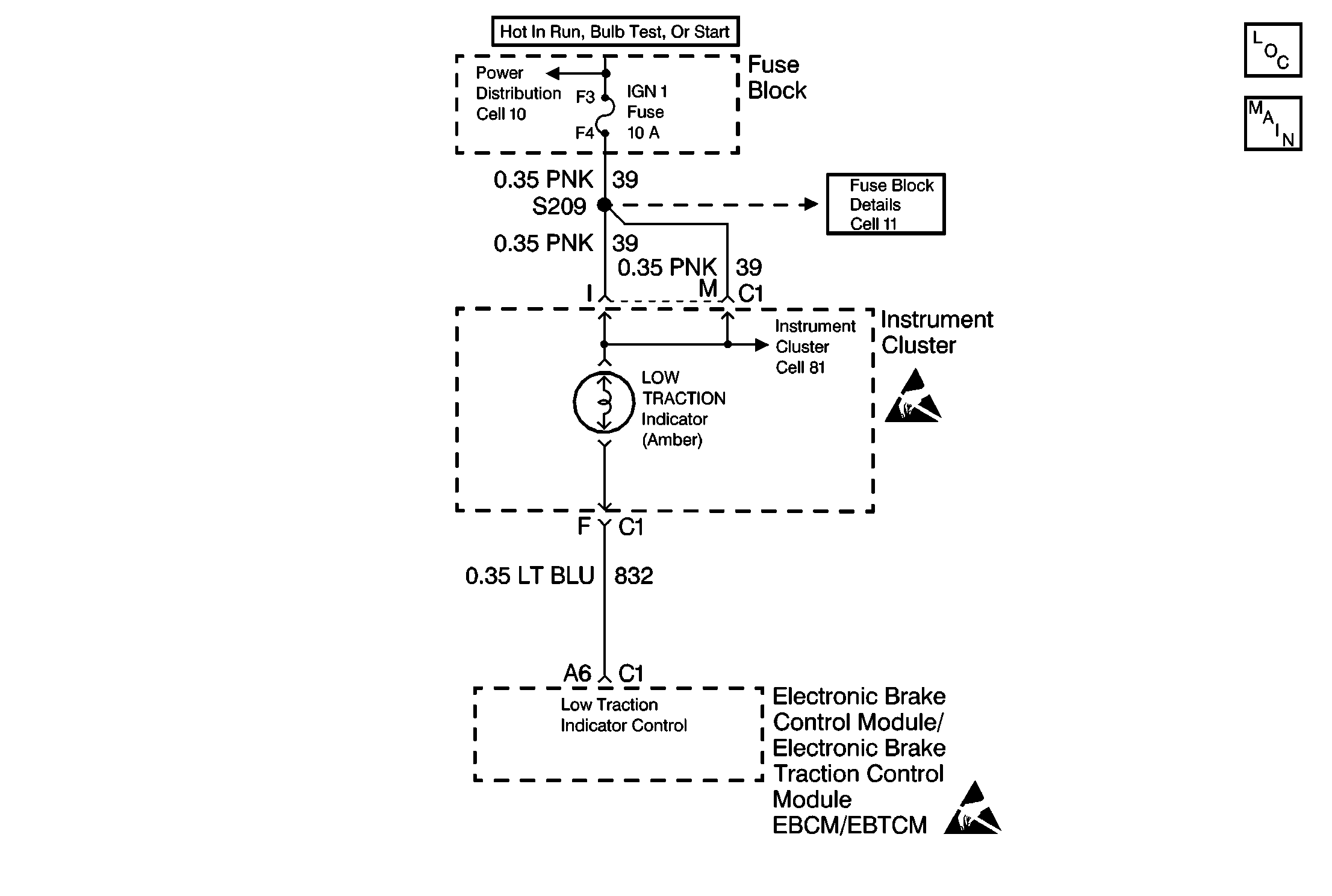
Circuit Description
DTC C1213 tests the state of the ABS (LOW TRACTION) active indicator. DTC C1213 identifies a situation in which the driver could not be warned of a low traction event by the ABS warning indicator or the ABS warning indicator is always on. The EBCM/EBTCM provides a ground through CKT 832 in order to turn the ABS warning indicator on. If the control line CKT 832 is open or shorted to voltage the ABS indicator will always remain off. If the control line CKT 832 is shorted to ground the ABS active indicator remains on when the ignition is in the RUN position.
This code will is use on basic ABS system and will not show up if vehicle is equipped with TCS (Traction Control System).
Conditions for Setting the DTC
DTC C1213 sets only during one of the following conditions:
| • | The three second bulb check |
| • | The indicator turns on. |
A malfunction exists if the EBCM/EBTCM cannot control the ABS active (LOW TRACTION) indicator for two seconds.
Action Taken When the DTC Sets
| • | A malfunction DTC stores. |
| • | The ABS does not disable. |
Conditions for Clearing the DTC
| • | The condition responsible for setting the DTC no longer exists and the Scan Tool Clear DTC function is used. |
| • | 100 drive cycles pass with no DTC detected. |
Diagnostic Aids
The following conditions may cause an intermittent malfunction:
| • | A poor connection |
| • | Rubbed-through wire insulation |
| • | A broken wire inside the insulation |
Use the Scan Tool Lamp Test function in order to command the indicator on while looking for an intermittent malfunction in the ABS active (LOW TRACTION) indicator circuitry.
Use the enhanced diagnostic function of the Scan Tool in order to measure the frequency of the malfunction. Refer to the Scan Tool manual or Scan Tool Diagnostics located in this section for the procedure.
Thoroughly inspect any circuitry that may be causing the intermittent complaint for the following conditions:
| • | Backed out terminals |
| • | Improper mating |
| • | Improperly formed or damaged terminals |
| • | Poor terminal-to-wiring connections |
| • | Physical damage to the wiring harness |
Important: Zero the J 39200 test leads before making any resistance measurements.
Step | Action | Value(s) | Yes | No | ||||||
|---|---|---|---|---|---|---|---|---|---|---|
1 | Was the Diagnostic System Check performed? | -- | Go to Step 2 | Go to Diagnostic System Check | ||||||
2 |
Can the ABS active indicator (LOW TRACTION) be turned on and off? | -- | Go to Step 22 | Go to Step 3 | ||||||
3 |
Does the ABS active indicator turn on and stay on? | -- | Go to Step 4 | Go to Step 7 | ||||||
4 |
Does the ABS active indicator turn on? | -- | Go to Step 17 | Go to Step 5 | ||||||
5 |
Are there signs of poor terminal contact, corrosion, or a damaged terminal? | -- | Go to Step 18 | Go to Step 6 | ||||||
6 |
Is DTC C1213 current? | -- | Go to Step 21 | Go to Diagnostic System Check | ||||||
7 |
Do the ABS and or the TCS indicators turn on and then off? | -- | Go to Step 8 | Go to Step 12 | ||||||
8 |
Does the ABS active indicator turn on? | -- | Go to Step 5 | Go to Step 9 | ||||||
9 |
Is the resistance within the specified range? | 0-2ohms | Go to Step 10 | Go to Step 19 | ||||||
10 |
Is any voltage present at the 24-way EBCM/EBTCM harness connector C1 terminal A6? | -- | Go to Step 20 | Go to Step 11 | ||||||
11 |
Is the repair complete? | -- | Go to Diagnostic System Check | -- | ||||||
12 |
Is the IGN 1 fuse (10A) open? | -- | Go to Step 13 | Go to Step 15 | ||||||
13 | Use the J 39200 in order to measure the resistance between terminal F4 and ground. Is CKT 39 continuous to ground? | -- | Go to Step 14 | Go to Step 16 | ||||||
14 | Repair the short to ground in CKT 39. Is the repair complete? | -- | Go to Step 16 | -- | ||||||
15 | Repair the open in CKT 39. Is the repair complete? | -- | Go to Diagnostic System Check | -- | ||||||
16 | Replace the IGN 1 fuse (10A). Is the repair complete? | -- | Go to Diagnostic System Check | -- | ||||||
17 | Repair the short to ground in CKT 832. Is the repair complete? | -- | Go to Diagnostic System Check | -- | ||||||
18 | Repair the 24-way EBCM/EBTCM connector C1. Is the repair complete? | -- | Go to Diagnostic System Check | -- | ||||||
19 | Repair the open or high resistance in CKT 832. Is the repair complete? | -- | Go to Diagnostic System Check | -- | ||||||
20 | Repair the short to voltage in CKT 832. Is the repair complete? | -- | Go to Diagnostic System Check | -- | ||||||
21 | Replace the EBCM/EBTCM. Is the repair complete? | -- | Go to Diagnostic System Check | -- | ||||||
22 | The system is functioning properly at this time. The malfunction may be intermittent or is not present at the time of testing. Is a concern still present? | -- | Go to Diagnostic Aids | Go to Diagnostic System Check |
